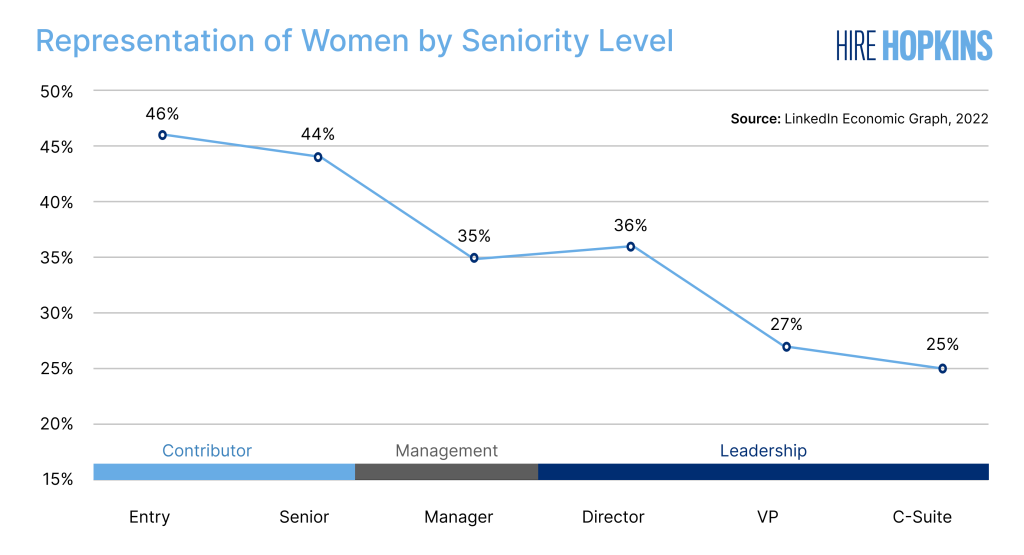
2023 is already shaping up to be a watershed moment for women in leadership. For the first time in the 68 years of existence of the Fortune 500 list, more than 10% of Fortune 500 companies are being led by women. January 1, 2023, marked the start date of five new Fortune 500 CEOs, which boosted the total number of women CEOs to 53. This number may seem insignificant, but we’ll take a moment to celebrate it, considering that the Fortune 500 list contained only two female CEOs in the year 2000.
That being said, we’ve got a ways to go in bridging gender gaps in leadership positions. According to LinkedIn, LeanIn.org, and McKinsey, the current leadership gender gap we see hinges on the first few years of employment. When a woman’s first promotion is delayed or never occurs, it has a domino effect on their whole professional trajectory. Such challenges only increase further up the seniority ladder, with men being 33% more likely than women to earn an internal leadership advancement.

As of 2022, only a few sectors, like personal services (“entities that provide personal services to individuals, households, and businesses”), education, non-governmental, and membership organizations, have near equal men and women representation in leadership. On the other hand, industries like manufacturing and construction have lower than 20% representation of woman in leadership positions. A complete breakdown of the percentage of women leadership in different sectors is shown in the figure below.

Progress toward equality can be frustrating for women who are just starting out in their professions. However, some organizations are leading the charge to ensure that women in their workplace are prepared to advocate for career advancement from the very beginning. From establishing objectives that hire and promote more women to forming women-focused Employee Resource Groups (ERGs), these organizations have identified various strategies to ensure the growth of women in the workplace. We have listed a few here for you.
How can you advocate for more women leadership?
1. Provide access to opportunities for growth and development
Eli Lilly and Co., the worldwide pharmaceutical company, has set an example of how companies that implement the correct women’s development and training opportunities can balance their leadership teams with greater diversity. Their success is evident as the company boasted 46% women representation in management positions globally in 2020.
The company provides various internal learning and development programs, speaker events, and teleconferences with Lilly’s women executives, and hosts an annual leader’s conference. These programs allow women in the workplace to navigate their responsibilities, identify career goals, acquire the necessary skills, and develop their leadership abilities.
2. End discrimination against working mothers
According to the Equality and Human Rights Commission, one-third of employers believe that pregnant women and mothers are less motivated in professional advancement than women without children or their male counterparts. Furthermore, a staggering 77% of working moms have encountered workplace discrimination. This discrimination, also termed as “maternal wall,” refers to prejudices faced by working moms and women seeking jobs.
While many American businesses are developing ways to accommodate working mothers, a lot more effort is required to go to eradicate bias against mothers in the workplace completely. Johnson & Johnson is one such company that understands the challenges faced by working mothers. The company offers several child care centers on J&J campuses, as well as a discount with a nationwide provider. They also include speech, occupational, and physical therapy for special needs children. The most significant step that the company undertook is in the form of its Re-Ignite initiative, which provides paid opportunities for people ready to return to work after a two-year or longer professional sabbatical.
3. Offer more flexibility
The pandemic demonstrated that working from home is a more flexible approach, especially for working parents who must balance their jobs and family life. Parents with young children might sync their work schedule to their baby’s sleep cycle. On the other hand, parents with older children may have to work around rigid school or extracurricular programs.
Bumble is one organization that has made it a mission to implement progressive standards for its staff, which currently number over 80 worldwide, with 85% of them being women. To better accommodate their team members, the company maintains a flexible interpretation of work hours and allows parents to bring their children to the office as required. One thing to keep in mind here, however, is that flexibility is an amplifier. If employees believe they must work constantly, flexible work will reinforce that feeling. Hence, although flexible working is a terrific tool, employers have to also pay attention to many of the conventional attitudes about work and work-life balance.
4. Provide equal pay
Pay systems that reward employees equally for the same amount of work increases efficiency and productivity by attracting talented employees and reducing staff absence and turnover.
Starbucks is one such company that has managed to achieve 100% pay equity in race and gender for equivalent occupations in the United States, as well as 100% gender equity in pay in China, Canada, and other company-operated worldwide markets such as Austria, Great Britain, Italy, and Switzerland.
Pay transparency is a huge step toward achieving pay equity, but it doesn’t only entail compiling a spreadsheet with each employee’s salary on it. It could be a proactive dialogue between management and staff. Many companies, like Whole Foods Market, JPMorgan, Macy’s, social media management tool Buffer, and the New York-based business SumAll, have fully implemented salary transparency. Here are a few steps you can take to do the same:
- You can start by explaining your company’s salary benchmarking process to your employees and potential candidates. Conveying this information transparently ensures that employees and potential candidates do not rely on secondary data to understand why they are paid the way they are. This is an excellent way to build trust with employees.
- Your company can also perform a compensation study for each role and look for “red-circle” personnel. These are employees who earn much more or less than others in comparable positions. Such a disparity in salary must be investigated immediately. It’s possible that the individual’s tasks do not correspond to their job title, or that they moved into a new function but their salary did not change. If there is no objective basis for the disparity, the manager or HR leader must address the issue.
- Pay transparency must become ingrained in a company’s culture. This may need some training, especially because discussing pay so openly is frowned upon in many work settings. Thus, your firms must normalize these dialogues, and executives, in particular, may need to develop new skills to properly handle pay concerns with employees.
5. Foster executive mentorships
Adobe, like many other Fortune 500 companies, believes in the importance of mentorship and, thus, provides women employees with the opportunity to join the Adobe and Women Employee Network (WEN), which provides networking opportunities and professional development programs for women employees around the globe. The WEN offers mentorship opportunities via the Women at Adobe Leadership Council (WALC). Here, mentees, such as directors or managers, are paired with Adobe senior executives for a six-month mentoring that includes insightful leadership roundtables on themes, including managing across the matrix and developing influence.
Like Adobe, companies that provide executive mentorship allow women to rise to higher positions, more effectively negotiate salary raises, and build social capital and confidence in a male-dominated corporate environment.
To guarantee that women have a voice in decision-making, they must first have a seat at the table. Though this endeavor will take time, organizations can begin a variety of initiatives to empower women as they enter and rise in the profession. This Women’s History Month is the right time to start such endeavors and help women in the workplace rise up the career ladder.

